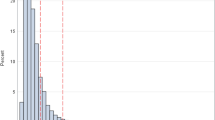Abstract
Introduction
Wait times for access to care have been of increasing interest to public health care officials, health care providers, and the public. There is a paucity of data determining whether extended wait times for melanoma surgery influence patient outcomes. This study measured the association of wait times to surgical treatment with overall survival in patients with melanoma.
Methods
Population-based health administrative databases were used to identify all Ontario adults diagnosed with melanoma between 2004 and 2011, time to various treatment modalities, and death dates. Proportional hazards modeling using time-dependent covariates was used to determine the adjusted association of time from melanoma diagnosis to various post-diagnostic surgical interventions with overall survival.
Results
A total of 2573 patients were included. The 5-year overall survival was 81.1% [95% confidence interval (CI) 79.1–83.0]. Of all patients, 82.9% underwent a wide local excision (WLE) with a median wait time of 43 days [interquartile range (IQR) 24–64], 29.1% underwent a sentinel lymph node biopsy (SNB) with a median wait time of 59 days (IQR 41–81), and 35.0% underwent a lymph node dissection (LND) with a median wait time of 63 days (IQR 43–91). After adjusting for age, sex, rural residence, and risk of mortality from comorbidities, wait times to WLE [hazard ratio (HR) 0.97; 95% CI 0.87–1.08; p = 0.62], SNB [HR 1.04; 95% CI 0.68–1.59; p = 0.86], and LND [HR 0.99; 95% CI 0.89–1.11; p = 0.92] were not associated with overall survival.
Conclusions
Overall survival for patients with melanoma was not influenced by wait times to WLE, SNB, and LND.

Similar content being viewed by others
References
Melanoma - SEER Cancer Statistics Review 1975–2013. National Cancer Institute. Accessed 14 Aug 2016.
Statistics Canada. Table 103-0553 - New cases and 1991 age-standardized rate for primary cancer (based on the August 2015 CCR tabulation file), by cancer type and sex, Canada, provinces and territories, annual, CANSIM (database). Accessed 14 Aug 2016.
Hajdarevic S, Hörnsten Å, Sundbom E, Isaksson U, Schmitt-Egenolf M. Health-care delay in malignant melanoma: various pathways to diagnosis and treatment. Dermatol Res Pract. 2014. doi:10.1155/2014/294287.
Murchie P. Treatment delay in cutaneous malignant melanoma: from first contact to definitive treatment. Qual Primary Care. 2007;15:345–51.
McKenna DB, Lee RJ, Prescott RJ, Doherty VR. The time from diagnostic excision biopsy to wide local excision for primary cutaneous malignant melanoma may not affect patient survival. Br J Dermatol. 2002;147:48–54.
Nelson DW, Stern S, Elashoff DE, Elashoff R, Thompson JF, Mozzillo N, et al. Impact of time between diagnosis and SLNB on outcomes in cutaneous melanoma. J Am Coll Surg. 2017;225:302–11.
Stoline MR. The status of multiple comparisons: simultaneous estimation of all pairwise comparisons in one-way ANOVA designs. Am Stat. 1981 35: 134–1.
Austin PC, Walraven CV. The mortality risk score and the ADG score: two points-based scoring systems for the Johns Hopkins aggregated diagnosis groups to predict mortality in a general adult population cohort in Ontario, Canada. Med Care. 2011;49:940–7.
Austin PC, van Walraven C, Wodchis WP, Newman A, Anderson GM. Using the Johns Hopkins Aggregated Diagnosis Groups (ADGs) to predict mortality in a general adult population cohort in Ontario, Canada. Med Care. 2011;49:932–9
Morton DL , Thompson JF, Cochran AJ, Mozzillo N, Nieweg OE, Roses DF, et al. Final trial report of sentinel-node biopsy versus nodal observation in melanoma. N Engl J Med. 2014;370:599–609.
Balch, C. M. et al. Final version of 2009 AJCC melanoma staging and classification. J Clin Oncol. 2009;27:6199–206.
White RR, Stanley WE, Johnson JL, Tyler DS, Seigler HF. Long-term survival in 2,505 patients with melanoma with regional lymph node metastasis. Ann Surg. 2002;235:879–87.
van der Ploeg APT, van Akkooi AC, Rutkowski P, Cook M, Nieweg OE, Rossi CR, et al. Prognosis in patients with sentinel node-positive melanoma without immediate completion lymph node dissection. Br J Surg. 2012;99:1396–405.
Faries MB, Thompson JF, Cochran AJ, Andtbacka RH, Mozzillo N, Zager JS, et al. Completion dissection or observation for sentinel-node metastasis in melanoma. N Engl J Med. 2017;376:2211–22.
Green AC, Baade P, Coory M, Aitken JF, Smithers M. Population-based 20-year survival among people diagnosed with thin melanomas in Queensland, Australia. J Clin Oncol. 2012;30:1462–7.
Kretschmer L, Starz H, Thoms KM, Satzger I, Völker B, Jung K, et al. Age as a key factor influencing metastasizing patterns and disease-specific survival after sentinel lymph node biopsy for cutaneous melanoma. Int J Cancer. 2011;129:1435–42.
Scoggins CR, Ross MI, Reintgen DS, Noyes RD, Goydos JS, Beitsch PD, et al. Gender-related differences in outcome for melanoma patients. Ann Surg. 2006;243:693–700.
Mervic L, Leiter U, Meier F, Eigentler T, Forschner A, Metzler G, et al. Sex differences in survival of cutaneous melanoma are age dependent. Melanoma Res. 2011;21:244–52.
Sedgwick, P. Retrospective cohort studies: advantages and disadvantages. BMJ. 2014;348:g1072.
Acknowledgment
This study was supported by the Institute for Clinical Evaluative Sciences (ICES), which is funded by an annual grant from the Ontario Ministry of Health and Long-Term Care (MOHLTC). The opinions, results and conclusions reported in this paper are those of the authors and are independent from the funding sources. No endorsement by ICES or the Ontario MOHLTC is intended or should be inferred. Parts of this material are based on data and information compiled and provided by Canadian Institute for Health Information (CIHI). However, the analyses, conclusions, opinions and statements expressed herein are those of the author, and not necessarily those of CIHI.
Author information
Authors and Affiliations
Corresponding author
Rights and permissions
About this article
Cite this article
Crawford, A.B., Nessim, C., Weaver, J. et al. Wait Times for Melanoma Surgery: Is There an Association with Overall Survival?. Ann Surg Oncol 25, 265–270 (2018). https://doi.org/10.1245/s10434-017-6146-2
Received:
Published:
Issue Date:
DOI: https://doi.org/10.1245/s10434-017-6146-2




